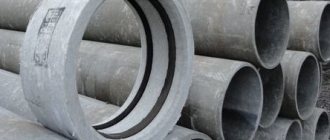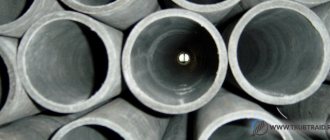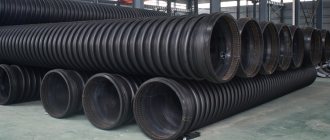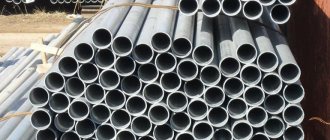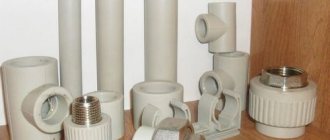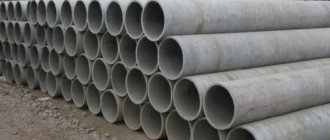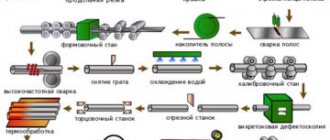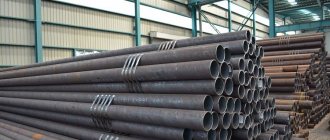Despite the rapid development of construction technologies, time-tested building materials are still widely used in industrial and civil construction. The widespread use of asbestos-cement pipes (ACP) in private construction is due to their unique technical characteristics, versatility and affordable cost.
This article discusses the main types, technical characteristics, scope of application, advantages and disadvantages of ADT. In addition, the relevant sections will detail the requirements for the laying and installation of asbestos-cement pipes and the features of their connection, both among themselves and with other elements of building structures.
What is an asbestos cement pipe?
Asbestos-cement pipes are made on the basis of components such as Portland cement (85%) and asbestos (15%). It is asbestos that reinforces the material.
At the first stage of asbestos pipe production, reinforcing fibers are formed, which are later mixed with Portland cement. The mixture thus obtained is thoroughly mixed until a homogeneous mass is obtained.
After this, the resulting solution is placed in a centrifuge, the inner diameter of which corresponds to the outer diameter of the product. Under the influence of centrifugal forces, the mixture is thrown towards the walls of the working cylinder of the centrifuge, as a result of which an asbestos-cement pipe of a given diameter is formed.
The last step is autoclaving. In a special chamber, the semi-finished product is processed with superheated steam. After this, the pipe is cut according to the requirements of the technical documentation and sent to the warehouse.
Important! Fine asbestos particles can cause irreparable harm to the respiratory system.
Carrying out work without special protective equipment is strictly prohibited!
Certificate of conformity
Cement-asbestos pipes are also used for pumping drinking water, which must be done in compliance with current hygienic and technical standards. For the installation and installation of pipelines, products for which a certificate of conformity has been issued are used. According to the requirements, the pipe must contain natural material with a permissible amount of radionuclides.
The certificate guarantees that the asbestos-cement pipe is safe from a radiation point of view. The document is issued after research has been carried out to determine the content of hazardous elements with radioactive influence. Thanks to special tests and inspection technology, conclusions are made regarding the safety of the material for humans and the environment.
Expert research is carried out in accredited laboratories, where asbestos-cement pipes are studied, and then a certificate is issued with a detailed description of these research results and the final conclusion. The certificate and the documents attached to it confirm the quality of the pipes and guarantee their safety.
Types of asbestos-cement pipes and their application
Depending on the purpose, asbestos-cement pipes can be produced in two versions:
- pressure;
- free-flow
Let's take a closer look at each of these modifications.
Pressure pipe
Requirements for pressure asbestos-cement pipes and their technical characteristics are regulated by GOST 539-80, according to which there are 4 modifications:
| Designation | Allowable pressure working environment in the pipeline, MPa |
| VT6 | 0,6 |
| VT9 | 0,9 |
| VT12 | 1,2 |
| VT15 | 1,5 |
Specifications
The service life and reliability of the pipeline depends on the correct choice of operating parameters of the pipes. Below are the technical characteristics of pressure asbestos-cement pipes, in accordance with GOST 539-80.
Scope of application
Due to their performance properties and affordable price, asbestos-cement pressure pipes are widely used. They are used for installation of water supply, sewerage, ventilation and drainage systems, storm drains, etc.
The material’s inertness to aggressive chemical compounds and corrosion resistance make it possible to use pressure pipes for transporting petroleum products and other aggressive media. In addition, the strength and heat resistance of the products ensures the possibility of their use in the installation of gas and steam pipelines.
Gravity pipe
Unlike pressure modifications, non-pressure asbestos-cement pipes are not used for laying pipelines operating under pressure. Technical characteristics and dimensions of non-pressure modifications are given in GOST 1839-80.
Technical characteristics of non-pressure asbestos pipes
According to GOST 1839-80, free-flow pipelines must meet the requirements given in the table:
Scope of use
Free-flow asbestos-cement pipes, due to their affordable cost, ease of installation and long service life, are widely used in industry and construction:
- when laying non-pressure water supply and sewerage communications;
- installation of garbage chutes in high-rise buildings;
- when assembling gas and chimneys;
- to protect the underground electrical network;
- as elements of a collector or drainage system;
- to protect communication cables, the Internet and other communications;
- as siege pipes for wells;
- when installing fences and fences;
- as pillars of a pile foundation;
- in private construction.
When properly used, asbestos products can last 30 years or more.
GOST 1839-80
Asbestos cement pipes are used to transport liquid working media by gravity. The diameters of asbestos-cement pipes are measured in millimeters, as is the wall thickness.
The exact characteristics and permissible areas of use of certain brands are regulated by GOST 1839-80.
Requirements that non-pressure asbestos pipes must meet:
- Ability to withstand pressure up to 4-6 atmospheres (the exact indicator depends on the class of the product)
- Resistance to longitudinal compression - pressure level is determined by diameter
- Homogeneity of the structure of the material itself – absence of delaminations, cracks, chips
- Exact compliance of the geometric dimensions of the product with the values specified in the passport documentation
When choosing a pipe, you need to focus on the parameters presented in the table:
During installation, pipes are laid using special couplings. In addition to installing various systems with gravity-flowing liquids, pipes can be used in the following way: gutters are made from BNT 100 pipes sawn along the axis, decorative fences, pillars, columns, flower beds are made, and they are chosen for the construction of chimneys.
Advantages and disadvantages
In addition to the above technical characteristics, the high demand for asbestos-cement pipes is due to the following advantages:
- at an affordable price.
Installation of a water supply or sewer network made of asbestos cement will cost 4-5 times less than a similar metal pipeline; - resistance to electrochemical corrosion and exposure to moisture and aggressive chemical compounds,
therefore, when installing pipelines, it is not necessary to carry out waterproofing and other protective measures; - low thermal conductivity
. The use of asbestos pipes allows, in most cases, to avoid insulation of the main line; - insignificant coefficient of thermal expansion
. When the temperature of the working environment increases to 1000C, the length of a five-meter pipe increases by no more than 0.5 mm; - versatility.
Can be used in a variety of areas, from laying main pipelines and protecting cables, to installing fences and installing pile foundations; - long service life.
When properly installed, asbestos cement products last from 25 to 35 years.
In addition, during operation, asbestos-cement pipes do not require maintenance, since practically no harmful deposits accumulate on the inner surface.
Along with the above advantages, the material also has a number of disadvantages, the most significant of which are:
- Asbestos pipelines and other structures are characterized by high fragility. They do not tolerate dynamic and alternating loads;
- when the temperature rises to 250 – 3000C, the product, as a rule, is destroyed, which limits the possibility of their use in steam pipelines and chimneys;
- laying of large diameter pipelines is carried out only using special equipment.
Despite these disadvantages, products made from asbestos cement are in demand not only in private, but also in industrial construction, as well as when laying pipelines working with aggressive working environments.
What is asbestos cement and why is it safe?
The basis of such a material as asbestos cement is dispersed reinforced concrete. In turn, asbestos acts as a reinforcing element. It is distributed in equal volumes over the entire surface of the pipe.
When the cement hardens, it forms a dense surface that hides the asbestos particles inside. The ratio of components in asbestos-cement pipes is as follows:
- 15 percent is asbestos;
- 85 percent is for cement.
At the same time, during operation, the emission of dust is completely eliminated, since asbestos is reliably bonded to concrete during the process of connection. Thanks to this, pipes of this type can be used not only for the installation of chimneys, but also for the construction of external pipelines, irrigation and ventilation systems, and in the construction of casing wells.
Is it possible to use asbestos pipes for a chimney?
Despite the affordable cost and ease of installation, a chimney made of asbestos-cement pipes is not the optimal option for discharging combustion products into the atmosphere. Before you begin constructing a chimney from this material, you must consider the following factors:
- exposure of the pipe walls to hot combustion products and moisture, combined with ultraviolet radiation, leads to the material delaminating, releasing fine asbestos particles into the environment. If it enters the human body, asbestos can cause exacerbation of chronic ailments and provoke cancer;
- The permissible heating temperature of the pipes is 280 – 3000C. This fact must be taken into account when choosing a heat generator. Overheating of a pipe can lead not only to its destruction, but also to more serious consequences (it can lead to an explosion);
- the presence of pores in the structure of the material promotes intensive absorption of condensate. With a significant decrease in temperature, internal connections are disrupted, which leads to gradual destruction of the pipes;
- to connect an asbestos-cement pipe to the outlet pipe of the heating boiler, use a special stainless steel adapter;
- It is advisable to install chimney elements at the maximum distance from the heat generator.
From the above it follows that asbestos products are not the best option for installing a chimney, however, subject to the appropriate rules and recommendations, their use is quite acceptable.
How to choose the size
The value of the characteristic depends on the tasks that the product will perform. The parameter affects the strength and weight of the model. Professionals calculate the diameter of an asbestos-cement pipe using special formulas, although there are standard recommendations.
The structures are produced in different sizes. The most popular in everyday life and construction are non-pressure models, the length of which is from 3.95 to 5 m, the internal diameter varies from 100 to 500 mm. For pressure structures, readings vary between 50-500 mm, wall thickness - from 9 to 43 mm.
Diameter of pressure and free-pressure pipesSource nwfasad.ru
The weight of asbestos-cement pipes is less than that of their steel counterparts. The weight of non-pressure models is 70-90% lower than that of pressure options. For example, a structure of 3.95 m and a diameter of 100 mm has a mass of the first types - 23.4 kg, of the second - 45.
Models with characteristics from 110 mm are suitable for main sewerage. In high-rise buildings, structures with parameters of 100 mm are used for risers. To connect plumbing, you need structures with a diameter of 50 mm. If you plan to connect several cottages into one system, then for the treatment line they take models from 150 mm.
Design for removal of combustion productsSource soyuzpolimer.com
When choosing a design for a water supply system, the hydraulic slope and the speed of fluid passage inside the system are taken into account. The parameter is influenced by the internal diameter of asbestos pipes and surface roughness. If you calculate data for household use, you can use the standard option. Products of ½ or 3/8 inches are suitable for wiring, and 1 or ¾ inches for risers.
The parameters of asbestos smoke exhaust structures should not be less than the outlet pipe of the heating equipment. To determine the diameter of the model, be sure to specify the volume of fuel burned (in the instructions). The characteristics are affected by the speed of gas movement through the channel, the height of the pipe and the outlet temperature.
Foundation made of asbestos-cement piles: application features
Since asbestos-cement pipes have high mechanical strength and are resistant to corrosion, moisture and aggressive chemical compounds, they can be used as the basis for a pile foundation.
Asbestos-cement piles are deeply dug pipes, the interior of which is filled with concrete and reinforced. Such supports provide a long service life and have sufficient load-bearing capacity for the construction of a small residential building, veranda or outbuilding.
Important! For the construction of a pile foundation, only pressure asbestos-cement pipes are used. The use of non-pressure modifications does not provide sufficient mechanical strength of the supports.
Advantages and disadvantages
Before you begin constructing a foundation made of asbestos-cement pipes, you need to evaluate its advantages and disadvantages. The advantages include:
- possibility of construction on difficult terrain;
- affordable price of the building materials used;
- relatively low concrete consumption;
- high speed of installation of supports;
- the ability to carry out installation work on your own;
- minimum amount of excavation work;
- long service life of the structure.
The most significant disadvantages can be considered the following factors:
Such a foundation can only be used for the construction of lightweight and frame buildings, since the bearing capacity of such supports is insufficient for capital construction using heavy building materials;
The construction of the foundation excludes the presence of a cellar or basement, however, this drawback is typical for any pile foundation;
Important! When installing supports, it is strictly forbidden to use pipes that have cracks, chips or other defects.
Construction order
The construction of a pile foundation with supports made of pressure asbestos-cement pipes is carried out in the following sequence:
- The load on the foundation is calculated and the required pipe diameter is selected;
- The construction site is being prepared, the necessary materials are being imported;
- Wells of the required depth are drilled;
- Pre-prepared sleeves are installed in the wells and aligned in a vertical plane using a plumb line;
- Filling and compacting wells;
- Installation of fittings;
- Filling the supports with concrete.
The construction of a foundation does not require special skills and tools; it is enough to approach the work carefully and responsibly.
Scope of application of asbestos cement pipes
Some areas where asbestos cement works can be used have already been mentioned, but this is just a small part. They are used:
- Drainage sewerage. Manufacturers currently offer perforated asbestos-cement products, which are used to collect and remove groundwater and atmospheric precipitation from suburban areas.
- Sewage systems: pressure and non-pressure. This is especially true for pressure sewerage, because asbestos-cement pipes can withstand pressure of up to 15 atm. Therefore, there is no need to install cast iron or steel pipes, which are several times more expensive than asbestos-cement pipes.
- Casing structure for drilling wells and finishing wells.
- The regulations allow the construction of garbage chutes in apartment buildings. This reduces building construction costs.
- Low thermal conductivity and large thickness of asbestos pipes make it possible to use them in chimney structures. At the same time, fire safety requirements are met one hundred percent.
- They are used to construct fences and various fencing structures as pillars.
- They are used to make permanent formwork for pouring columnar foundations and support pillars for floors.
- Designers also pay attention to asbestos-cement pipes. Flowerpots, flower beds, decorative stands, and so on are made from them. Fortunately, these products are easy to process, and this is another advantage.
Laying and installation requirements
In order for a pipeline or other building structure made of asbestos-cement pipes to be reliable and durable, the following rules must be observed during installation:
- Before starting installation work, pipes and couplings should be carefully checked for cracks, chips, etc. The use of substandard products can lead to premature failure of the structure;
- the operational characteristics of asbestos cement pipes must clearly correspond to the operating pressure in the pipeline and the temperature of the working environment;
- when joining, both elements must fit into the coupling all the way, this will ensure the reliability and tightness of the connection;
- When laying main pipelines, the alignment of individual elements should be monitored. Misalignment can lead to destruction of the coupling or depressurization of the joint;
- During installation work, shock loads must be avoided. Even if the material does not collapse, microcracks may form in its structure, leading to premature destruction of the pipe. The danger of microdefects lies primarily in the fact that it is almost impossible to detect them during the installation of the structure.
Installation features
To lay an asbestos-cement pipe, a number of specific requirements must be met. These include:
- Pipes with a diameter of more than 15 centimeters require additional processing. This helps to adjust the pipe to the desired size and get rid of roughness.
- The pipes must be connected using special couplings. They have grooves that act as rubber sealing rings. This helps ensure a tight connection between the pipes and constant pressure.
- A radial gap is left at the junction of the pipes, which ensures deflection of the pipeline when it fails.
- When installing pipes with a diameter of more than 15 centimeters, an indentation is made. This is necessary for installing additional linear compensators.
How and how to cut asbestos pipes
When assembling building structures made of asbestos, it is almost impossible to avoid cutting them. There are several ways to cut asbestos-cement pipes.
- Using an angle grinder (grinder).
This method is the most effective and provides high quality cuts. Cutting asbestos pipes is carried out with diamond saw blades or concrete saw blades. In order to minimize the amount of asbestos-cement dust generated during the cutting process, it is better to work together: the operator, using a grinder, cuts the pipe, and his assistant ensures a continuous supply of water to the cutting zone.
Important! Since fine asbestos-cement dust has carcinogenic properties, the use of protective respirators is mandatory when processing the pipeline!
- Using a hacksaw.
Considering the fact that wet asbestos cement can be cut much easier than dry, the pipe should be wetted before cutting. Cutting is carried out along a pre-designated line, avoiding strong pressure. Although cutting with a hacksaw will require more time and effort, the amount of dust generated when cutting pipes with a hacksaw is much less than when cutting with a grinder. - Using a cutter.
A line is drawn along the circumference of the pre-moistened pipe at the cut site. An incision 2-3 mm deep is made along the marked line, after which the pipe is carefully broken. The main advantage of this method is the absence of dust. - Using a slate nail.
If you don’t have the necessary tool at hand, and you need to cut the pipe immediately, an ordinary slate nail can help. The pipe is wetted and a cutting line is applied. The nail is sequentially hammered into the pipe along the marked line, and then broken off. The closer the nail holes are to each other, the more accurate the cut will be.
In addition, an asbestos-cement pipe can be quickly cut with a circular saw if you install a saw blade with carbide tips on it.
Installation methods
When installing asbestos cement pipes you need to know:
- rules for preparing for connection;
- connection methods;
- rules for laying external pipelines.
Preparing for connection
Before connecting, asbestos pipes are prepared:
- cut according to the dimensions specified by the project. Cutting is done using a regular hacksaw, jigsaw or grinder;
Cutting pipes to size
- the ends of the products are cleaned as much as possible from contaminants, and if necessary, the chamfer is removed;
- If you need to insert a tee or any other fitting into the pipeline, then a hole of the appropriate diameter is drilled in the pipe.
How to properly cut a pipe, watch the video.
Connection of asbestos pipes
The connection is made using special couplings, which are equipped with O-rings.
Coupling for asbestos pipes
Couplings can be manufactured:
- from asbestos;
- made of cast iron;
- made of plastic.
The dimensions of the couplings are selected in accordance with the outer diameter of the pipe; for example, to connect pipes with a diameter of 300 mm, a coupling with a similar diameter will be required. Permissible deviations from dimensions are +1.5 or -1.0.
The coupling must also be selected in accordance with the type of pipes, that is, non-pressure pipes are connected with gravity couplings, and pressure pipes with pressure couplings.
The connection with couplings is made according to the following scheme:
- the surface of the pipe on which the coupling will be placed is treated with a graphite-based lubricant. This will simplify the connection process as much as possible;
- a coupling is put on the first pipe;
- the pipe is lowered into the trench to a permanent place;
- the second pipe is lowered and approaches the connection point at a minimum distance;
- the alignment of the products is checked and the second pipe and coupling are joined;
- if necessary, the space between the pipes and the edges of the coupling is filled with mastic or other sealant.
Rules for connecting asbestos pipes
How to make a hole in a pipe
When installing sewer, water supply and drainage systems, it often becomes necessary to drill a hole in an asbestos-cement pipe. Depending on the shape and size of the hole, various tools and devices can be used.
To drill holes with a diameter of up to 12 mm, drills with a Pobedit tip are used. You can also use a sharpened drill bit for a hammer drill. As a last resort, a hole can be drilled with a regular metal drill, but you should take into account the fact that when working with pipes and sheet materials made from asbestos cement, the tool quickly becomes dull. Processing of holes is carried out exclusively in a shockless mode, since asbestos pipes do not tolerate dynamic loads well.
When drilling holes whose diameter ranges from 15 to 120 mm, carbide or diamond core drills (crowns) with a centering drill can be used.
To obtain large-diameter holes or inspection windows, holes with a diameter of 8–10 mm are drilled around the perimeter, after which the excess material is knocked out using a chisel and hammer. The more holes drilled, the higher the hole accuracy and edge quality.
Price per meter
Asbestos-cement pipes offer fairly low prices along with excellent performance characteristics. Prices may vary depending on the brand, manufacturer, and region of sale, but are within an acceptable range.
Asbestos-cement pipes allow you to reduce costs not only due to the cost of the products themselves, but also during the installation process.
If steel pipes need to be laid at a certain depth, insulated, and installed using special equipment, then asbestos products require simpler requirements and help save time, money, and effort.
How to connect pipes
When installing building structures made of asbestos cement, the strength and tightness of the connections play the most important role. During the work, it may be necessary to connect asbestos pipes not only with each other, but also with other materials. Let us consider the features of ACC docking in more detail.
Connecting asbestos-cement pipes to each other
This is the simplest and most common option. Asbestos-cement pipes can be connected to each other in two ways: in a socket and using couplings of various designs.
Socket connections
Sealing socket joints is associated with significant difficulties caused by the significant mass and fragility of asbestos-cement pipes; in addition, such joints are not particularly strong and reliable. In practice, socket connections are used for pipelines in which there is no operating pressure.
Coupling connections
The following types of couplings can be used for coupling connections:
- asbestos-cement coupling with rubber sealing rings;
- non-pressure asbestos-cement coupling;
- cast iron flange coupling “Zhibo”;
- polyethylene coupling MPT (PVD).
Each of these compounds has its own characteristics.
Coupling with rubber O-rings
Considering the coupling, it is a cylindrical sleeve with two grooves for installing rubber sealing rings. The dimensions and shape of the product are regulated by GOST 1839-80.
Installation of the coupling is carried out in the following sequence:
- coupling with sealing rings installed in it; placed on the bottom of the trench;
- using levers or a jack, the coupling is pushed all the way onto one of the pipes being joined;
- the second pipe is inserted into the coupling in the same way.
Subject to high-quality joining, this method ensures high strength and tightness of the connection.
Free-flow asbestos-cement coupling
Docking with the help of such couplings is used when laying non-pressure main pipelines. The docking order is as follows:
- Two holes with a diameter of 20-25 mm are drilled in the coupling on one line;
- On the outer surface of the connected elements, mark the required position of the coupling after joining;
- The outer diameter of the articulated pipes is wrapped with roofing felt or other bitumen waterproofing material;
- The coupling is pushed onto the mating pipes so that the holes are on top;
- The resulting gap is filled 1/3 with tow on both sides;
- Melt bitumen resin is poured through the drilled hole until the free space between the outer surfaces of the articulated pipes and the inner surface of the coupling is completely filled. When the cavity is completely filled, hot bitumen will begin to pour out of the second hole.
To ensure a reliable and durable connection, during the installation process it is necessary to ensure the alignment of the joined elements, otherwise the joint may depressurize.
Cast iron flange coupling "Zhibo"
The coupling design includes the following elements:
- two flanges;
- mounting sleeve;
- rubber O-rings;
- coupling bolts.
Installation sequence:
- a flange, a mounting sleeve and a rubber sealing ring are put on one of the pipes being joined;
- the remaining parts of the sleeve are put on the second pipe;
- the articulated elements are laid in such a way that their axes coincide;
- Using special bolts, the coupling flanges are tightened.
The main disadvantage of such a connection is the possibility of corrosion destruction of the coupling ties, which can lead to depressurization of the connection.
Polyethylene coupling MPT
Such couplings are used for installation of non-pressure pipelines and protective channels for cables. The product is a cylindrical sleeve with an internal dividing flange that ensures uniform joining. The coupling is pulled onto the mating elements until it stops against the locking collar.
Features of connection with a plastic pipe
If it is necessary to connect a plastic pipe with an asbestos-cement pipe, the best option is to use a special adapter with the appropriate diameters. If the outer diameter of the pipes is the same, and the connection is made in a free-flow line, you can use a PVC coupling for asbestos-cement pipes.
Connection with metal pipes
Most often, the need for such a connection arises when installing chimneys. Since it is advisable to use asbestos-cement pipes at a sufficient distance from the outlet pipe of the heating boiler, it is necessary to join it with metal. You can ensure the strength and tightness of the connection using a special stainless steel adapter.
The use of asbestos-cement pipes in modern construction and industry is due, first of all, to their affordable cost. In addition, resistance to moisture and aggressive chemical compounds, combined with high strength and ease of installation, have made them widely popular in private construction. Particularly noteworthy is the fact that during operation, asbestos-cement pipes do not emit any harmful substances and are completely safe for humans.
Dimensions
The length can vary in the range of 3.95-5 meters. The throughput value can be: 100, 150, 200, 250, as well as 300, 400, 500 millimeters. Before determining the diameter, it is necessary to consider their two main types.
All asbestos-cement pipes and couplings for their installation are divided into two types: free-flow for sewerage (production is regulated by GOST 1839-48) and pressure for water supply (must comply with GOST 539-59). The internal and external diameters and wall thickness are indicated in millimeters.
The data is presented in tables:
Classification of asbestos cement pipes
The production of asbestos products is regulated by GOST 539-80 (pressure) and GOST 1839-80 (non-pressure), which determine that asbestos-cement pipes can be produced with a diameter of 100 mm to 500 mm, and their length has 2 standard sizes: 3.95 and 5 m.
Pressure
Asbestos-cement pressure pipes are classified according to the pressure of the medium passing inside them. They are divided into 4 classes:
- VT6 – can withstand pressure up to 6 kgf/cm², which is almost 6 atm. To connect such products, a coupling of the CAM6 brand is used.
- VT9 – maintain a pressure of 9 atm, a SAM9 brand coupling is used.
- VT12 – 12 atm, coupling SAM12.
- VT15 – 15 atm, coupling SAM15.
The indicated pressure is the maximum provided that there is no external pressure on the pipeline.
Pressure asbestos-cement pipes are divided into 3 more types, which are based on the internal diameter and length of the product. We will not analyze all the proposed options; we will consider only one with a nominal bore of 200 mm, which will show the difference.
| Brand of asbestos cement pipe | Inner diameter, mm | Wall thickness, mm | Length, m |
| VT6 | 196 | 14 | 3,95 |
| VT9 | 189 | 17,5 | 3,95 |
| VT12 | 181 | 21,5 | 3,95 |
| VT15 | – | – | – |
| Brand of asbestos cement pipe | Inner diameter, mm | Wall thickness, mm | Length, m |
| VT6 | 200 | 12 | 5,0 |
| VT9 | 196 | 14 | 5,0 |
| VT12 | 188 | 18 | 5,0 |
| VT15 | 180 | 22 | 5,0 |
| Brand of asbestos cement pipe | Inner diameter, mm | Wall thickness, mm | Length, m |
| VT6 | 196 | 14 | 5,95 |
| VT9 | 189 | 17,5 | 5,95 |
| VT12 | 181 | 21,5 | 5,95 |
| VT15 | 176 | 24 | 5,95 |
Please note that the pressure versions have a machined chamfer to fit into the coupling. It is smaller in outer diameter. The length of the chamfer should not be less than 20 cm.
Gravity
This type of pipe does not have a seat chamfer, i.e. they are purely straight. As in the previous case, asbestos products are divided by size. True, the range is not so large.
- Conditional pass: 100; 150; 200; 300 and 400 mm.
- Wall thickness respectively: 9; 10; eleven; 14 and 17 mm.
- Length: the first two diameters have two indicators: 2.95 and 3.95 m, the last three have only 3.95 m.
Application for drainage device
Closed drainage systems can be equipped with asbestos pipelines. General installation rules are as follows:
- Drainage pipes must have perforations - holes for water penetration.
- For gravity movement of water, drainage systems must be placed at a slope towards the direction of liquid removal.
- Digging trenches can be done manually or using construction equipment.
- As a rule, drainage pipes with a diameter of 100-200 mm are installed, however, in cases where it is necessary to build drainage systems of increased productivity, installation of products with a diameter of 300-400 mm is allowed.
Drainage pipe with perforation
Also, asbestos cement products are used to construct wells that serve drainage networks. Asbestos cement can be laid to great depths. The walls of the products are not destroyed under the influence of an aggressive environment and do not require complex manipulations for maintenance.
Drainage pipes made of asbestos cement are easy to maintain and will last up to 20 years. Previously, asbestos products dominated the laying of drainage networks, but recently they are increasingly being replaced by a more modern material - plastic. Plastic pipes are lighter, which greatly simplifies the installation process.
